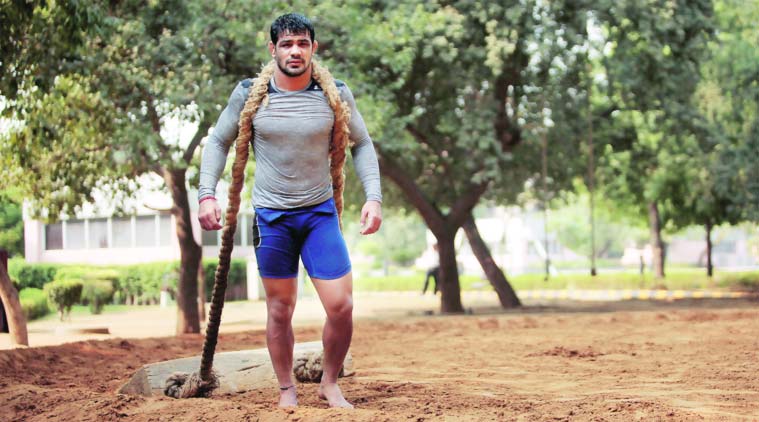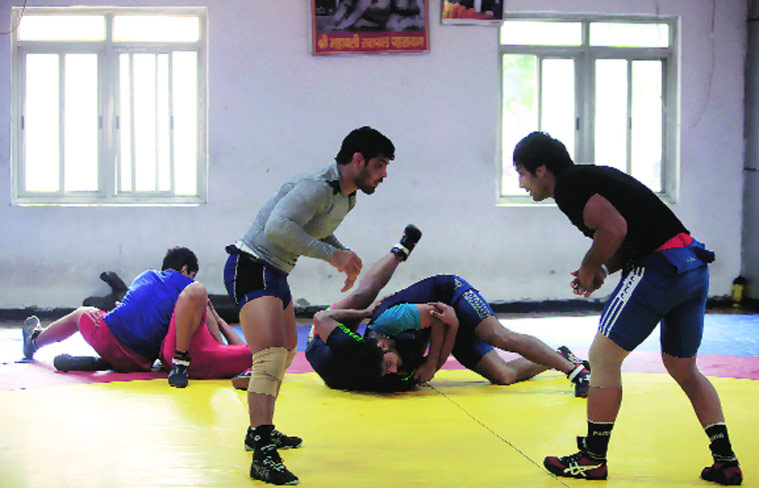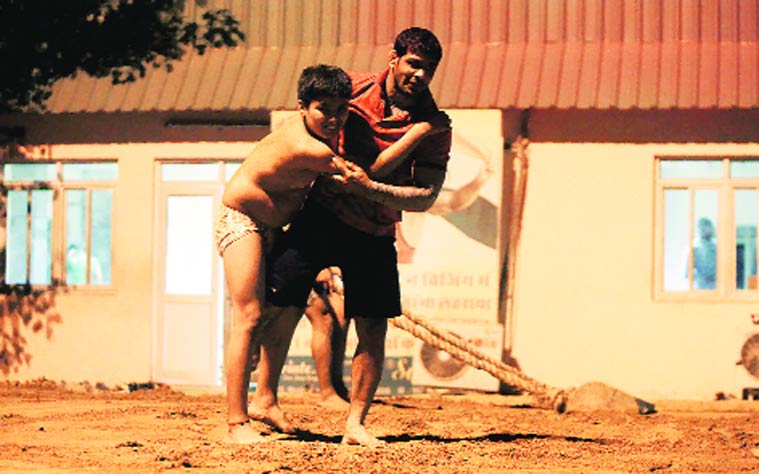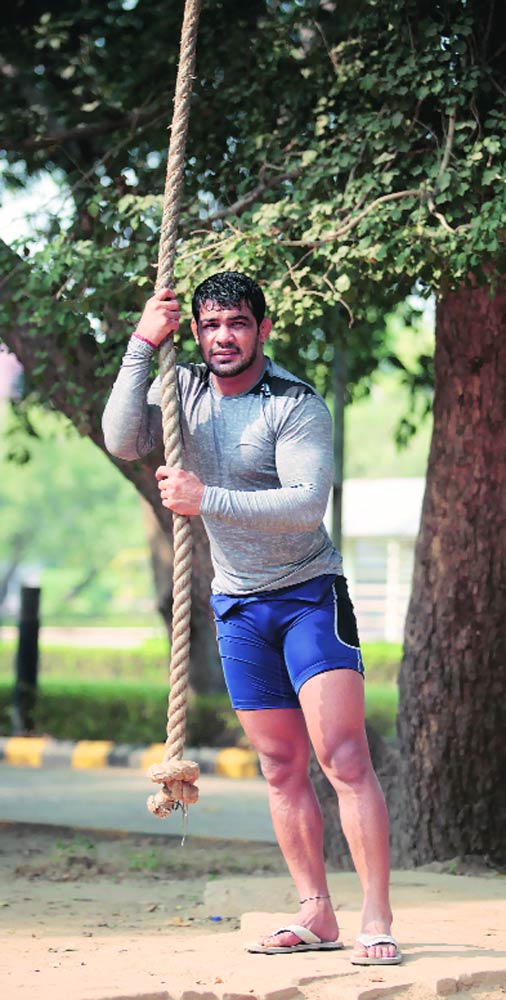Matman Sushil Kumar returns for 2016 Rio Olympics
 The akhara at Delhi’s Chhatrasaal Stadium is double Olympic medallist Sushil Kumar’s first home. (Source: Express photo by Amit Mehra)
The akhara at Delhi’s Chhatrasaal Stadium is double Olympic medallist Sushil Kumar’s first home. (Source: Express photo by Amit Mehra)
In the three years since winning his second Olympic medal, Sushil Kumar has managed just one major appearance — at Glasgow CWG — owing to prolonged injury spell. As he returns to full fitness and jetsets to Georgia, Mihir Vasavda visits the akhara to watch how the champion is preparing to win a third
“You know, bhaiya can perform around 80 rope climbs at one time. And in a minute, he can execute around 100 pulls ups,” says the proud voice on the other side of the phone. “Aur kaafi kuch kar sakte hai. Dekhenge toh manenge (He can do a lot more. You have to see it to believe it.)”
Ajay Sherawat, Sushil Kumar’s roommate and sparring partner, is in awe of the wrestler. So at first, you feel this is one of those exaggerated myths you constantly hear that, in a way, add to the legend of the two-time Olympic medallist. But these stories are then repeated and rehashed by almost everyone who knows Sushil, lending some credence to it.
So you decide to go check it out yourself. It is a good time to see Sushil train, since he has regained full-fitness for the first time since London 2012. And for a month starting Sunday, he will be in Georgia, officially kick-starting his preparations for next year’s Rio Olympics. “Akhare pe aa jaiye,” says Sushil, when you ask him if he can spare some time. The akhara at Delhi’s Chhatrasaal Stadium is his haven. A no-frills place with nothing but a tiny wrestling hall, a mud pit and ropes hanging from the surrounding trees.
He may train and compete at state-of-the-art arenas across the world but a desi akhara is where he feels at home. It’s been his meeting point ever since the two-time Olympic champion shot to fame. After returning as a bronze medallist at the Beijing Games, the akhara is where most scribes and the VIP’s queued up to meet him. He repeated the standard ‘Akhare pe aa jaiye’ line after winning the Khel Ratna in 2009 and silver medal at London Olympics in 2012. Even when American WWE star Kurt Angle came to India two years back, he met Sushil at the akhara.
Of late, it has also become his work place. Once a trainee, Sushil is now the chief administrator here. It’s a busy mid-week evening. After glancing through a few files, he emerges from behind his desk in an orange t-shirt and dark blue jeans. “Let’s walk,” he says with an earthy smile.
Sushil has to oversee kabaddi trials for the national school games. But he does not walk. He runs. So does his entourage. From his office in the stadium premises to the kabaddi ground; from the kabaddi ground to the changing rooms, Sushil runs. The tiny room under the bleachers at the Stadium has a couple of wooden cots pressed close for his roommates to share. There are a few chairs and on the altar are medals he won in his early career. An image of Hanuman is placed next to the medals.
Sushil changes into a pair of shorts and runs, again, towards the akhara. He finally comes to a halt near a 25-foot tree, from where a rope is hanging loose. As he stretches his arms and greases his palms, 100-odd trainees form a semicircle around him, waiting for the Sushil show to begin.
Sushil fools around with his trainees and hums a bhajan along with one of them before he begins his climb. Once he begins, there are collective gasps as people watch a jaw-dropping display of athleticism. Standing at some distance, Sherawat smiles. He has the ‘told-you-so’ look on his face, as Sushil continues to clamber up and down the tree.
Finally, after he is done 45 minutes later (you lose count of the number of climbs he has completed), you ask Sushil about his shoulder. “Don’t even mention it. Injury is a taboo word here,” Sushil snaps, not wanting to be reminded of the ‘toughest phase’ of his career where he came close to giving up what he loves doing the most.
Long layoff
SHERAWAT can’t recall the exact day, but this is sometime in mid-2013. After a routine training session at the Chhatrasaal, Sushil returned to his room in apparent discomfort. During the practice bout, Sushil, who competes in the 74kg category, was grappling against a wrestler weighing 90kg. It’s a common practice amongst wrestlers to fight men heavier than them to improve their strength. But at some point during the bout, Sushil injured his collar bone.
He didn’t feel the pain immediately but once the body cooled down, the 32-year-old couldn’t move his arms freely. He was still recovering from a shoulder injury and this worsened his condition. “The doctor who examined Sushil told me in private that chances of him returning to wrestling were 50-50. If he rushed through this phase and didn’t give enough time for the injury to heal, he would have to quit wrestling for good,” says Satpal Singh, Sushil’s coach and father-in-law.
The wrestler mandated Olympic Gold Quest (OGQ) to ensure he recovers in time for the Rio Olympics, even if that meant staying away from the mat for a long duration. “The injuries were serious and there were times when he would be frustrated but Sushil knew he had to be patient. It was more about preparing him physically because mentally he is extremely calm. He was extremely focussed in terms of what he needed. That made things a lot easier to deal with,” OGQ CEO Viren Rasquinha says.
There used to be occasional bouts of frustration and anxiety, especially when he started to miss camps and tournaments frequently. Barring a brief period when he trained for and competed at the Glasgow CWG last year, Sushil could not even step on a wrestling mat. Nor could he perform any of those crazy upper body exercises, which had become a part of his urban legend. He would run, play football and run more to ensure he maintained his fitness.
There was a welcome distraction in the form of his twins, who were born during this period, and his new role as a sports administrator. “It kept me happy, the kids especially. There was something new to look forward to.
Fatherhood taught me there’s more to life than wrestling,” Sushil says.
However, staying away from the mat for such a long period had slowed him down considerably. Once he recovered fully a month-and-a-half back, Sushil’s challenge has been not only to ensure he doesn’t over-exert himself, but also to increase his speed on the mat. “Around two hours in the morning, and two hours in the evening. The little time off I get in the afternoon is to catch some sleep and finish the administration work,” he adds.
The training regime can easily be a part of the montage that forms a critical element of most sports movies. “He does a hundred pull-ups in a minute; sometimes with weights tied around his calves. On some days, he will perform around 70-80 rope climbs and also goes for 10km cross-country runs occasionally,” Satpal says. “On some weekends, he piggybacks a wrestler weighing more than him and runs around 800m on the incline at the Delhi Ridge, which helps in strength and endurance. To improve his speed, he indulges in short sprints of 50m.”
New techniques
MOST of his time, however, was spent in front of his laptop watching videos of his opponents. The wrestling landscape has undergone tremendous change since Sushil picked up an injury and started to sit out.
His preferred category, 66kg, was removed from the Olympics by the international wrestling federation, which forced him to move up to 74kg. He won the CWG gold in his new weight category but the pool of his opponents has expanded considerably, which has resulted in more home work before the bouts.
While monitoring what his rivals have been doing, Sushil has had to adapt himself as well. The phitleys (leg-locks) or teggas (pin-down) are no more the surprise weapon in his armoury.
Consequently, in the last few months Sushil and Satpal have come up with a dozen new techniques, which he has been practising with his sparring partners.
One of the new tricks involves catching the opponent from his thigh and pinning him down. “We usually target ankles or calves to get a proper grip so this is a surprise element if this if executed properly. There are other variations as well if we have to attack an opponent from the front,” Satpal, an Asian Games gold medallist himself, says.
Every technique, which lasts barely five seconds, is repeated nearly a 1,000 times during each session according to the coach. Sushil won’t try any of the new tricks during his stint in Georgia for the fear of them recording it and using it for future reference. “The basic purpose of this trip is to get better sparring partners and also have a look at their wrestlers, since I have been out of action for a long time,” Sushil says.
The stint in the Eastern European country might prove to be handy for Sushil, considering they have a decent field in the 74kg category. Their top wrestler, Jumber Kvelashvili, recently won a bronze medal at the European Games.
To get more exposure before the Olympics, Sushil will be taking part in invitational tournaments in USA and Italy before another likely training stint in America.
Sushil knows a stint in the US will be crucial. America’s reigning Olympic gold medallist Jordan Burroughs is the man to beat in the 74kg category. Burroughs has won a medal at every tournament he has taken part in since 2011, including gold medals at three World Championships, two Pan American Games, one Pan American Championship and, of course, London 2012. Sushil has never faced him before as the Indian was earlier in the lower weight category.
Challenge back home
BUT before Sushil trains his guns on Burroughs, he will have to conquer the challenge he is facing back home. Narsingh Yadav, India’s original choice in the 74kg until Sushil made the jump, has been making all the right noises of late.
Till a couple of months back, Sushil would have been India’s automatic choice and obvious favourite for a medal in Rio. But Narsingh reminded the country of his abilities by winning a medal at the World Championships in Las Vegas last month, thus earning an Olympic quota. Since every country is alloted just one berth, the toss-up is now between Sushil and Narsingh for the elusive spot. “I wasn’t fit for the trials for the World Championship so it would not have been right on my part to delay team selection. Winning a medal and an Olympic quota is an incredible achievement by Narsingh. He has proven what a good wrestler he is,” Sushil says.
Whether the federation chooses to conduct a face-off between the two or unilaterally select a wrestler remains to be seen. Sushil says he is ready for any eventuality as long as it results in a medal. “I am ready for a trial or go by whatever the federation decides. Ultimately, our focus should be on winning the gold,” he says.
That, according to Satpal, is more likely if his son-in-law is given an opportunity. Tactically and technically, Sushil – says Satpal – is better equiped to beat Burroughs. It’s as if he has assumed that the American will reach the final and stands between Sushil and a gold medal. Going by Burroughs’ record, however, Satpal may not be far off the mark.
“If we send Sushil, we should not expect a bronze or silver from him. This time, it’s natural to expect a gold from him and even he realises that.” Satpal says. “I don’t mean disrespect to Narsingh, but Sushil is the only man who can beat the American. He, after all, has the strength of a bull.”
Wrestlers love to hyperbolize. But see him train in flesh and you realise Satpal’s claim isn’t a mere exaggeration.
***
WHAT HE EATS
A vegetarian, Sushil’s routine diet includes:
2 litres of milk per day
Half kg almonds (partly crushed and mixed in water)
Half kg ghee
Chapati, daal, green vegetables, paneer
HOW HE TRAINS
His weekly training includes (subject to change according to schedule):
Monday: Morning – jogging, mat-work; evening – rope climbs followed by basketball/football/ handball
Tuesday: Jogging followed by mat-work
Wednesday: Running and speed drills (short sprints, etc)
Thursday: Morning – jogging, mat-work; evening – rope climbs followed by gym or a game of basketball/football/handball
Friday: jogging followed by mat-work
Saturday: Cross-country running (10km) or 800m incline run at Delhi Ridge
Sunday: Rest day
* According to his sparring partners, Sushil Kumar can execute around 100 pulls in one minute with 10kg weights tied around his calves
* He can perform around 70-80 rope climbs in one session that lasts around 45 minutes
* Incline at Delhi Ridge a sparring partner who weighs heavier than him as a piggyback
* Around 1,000 repetitions on one technique in one session, according to coach Satpal Singh. One repetition takes around five seconds








